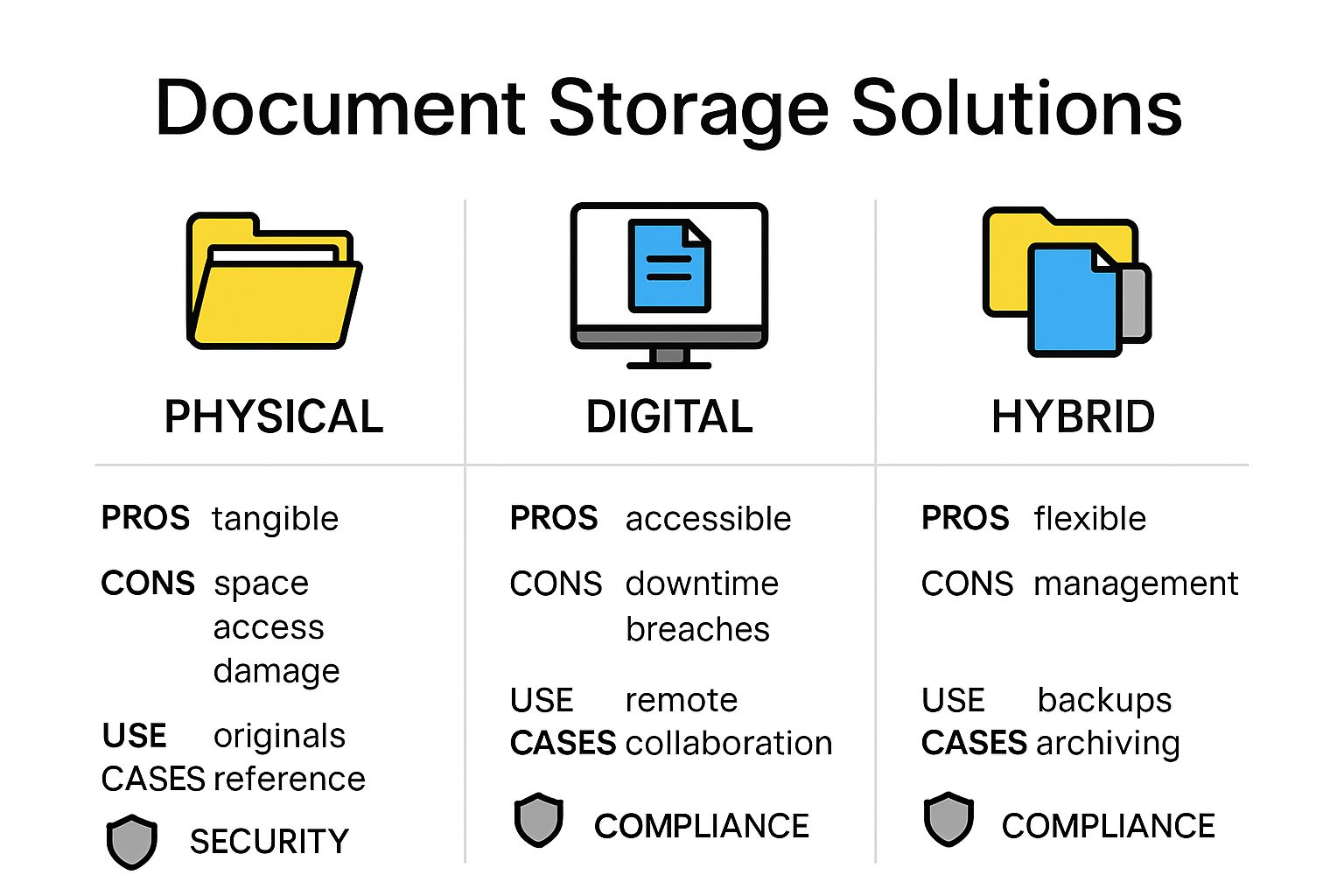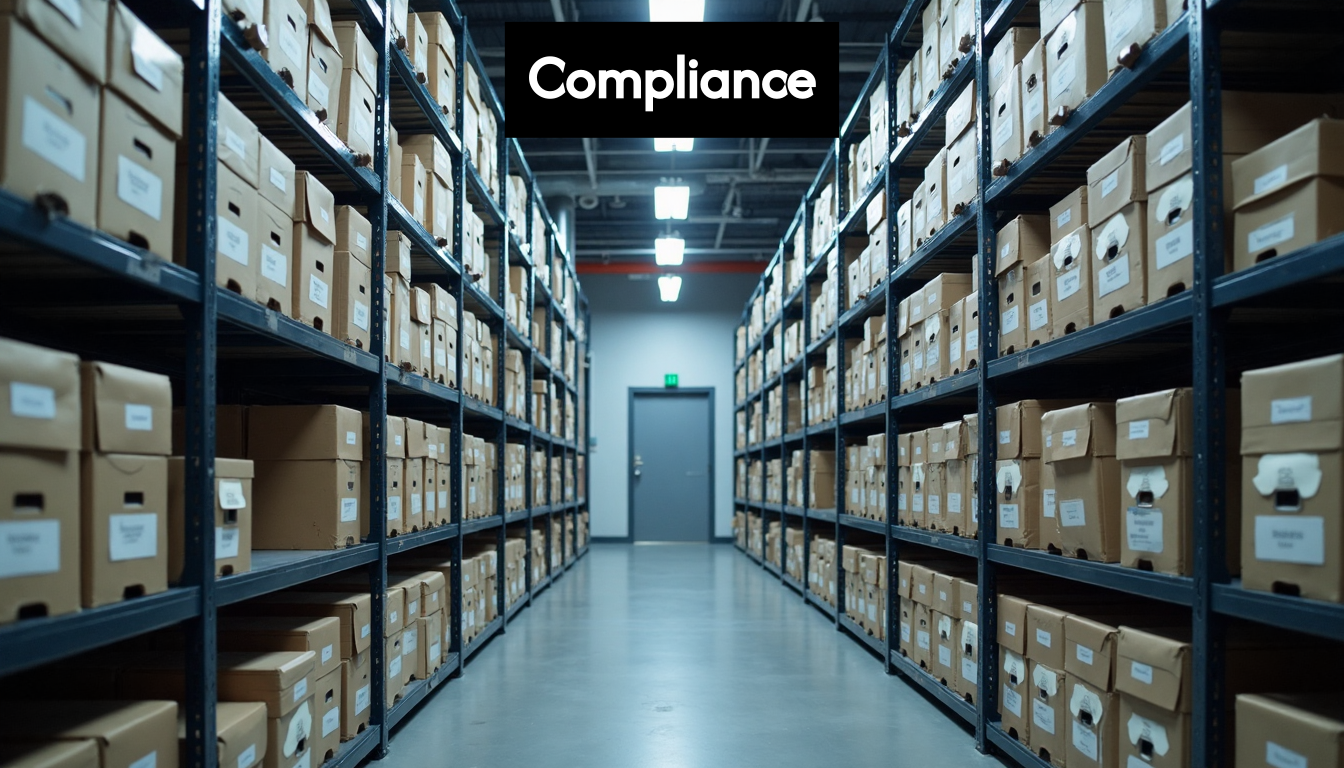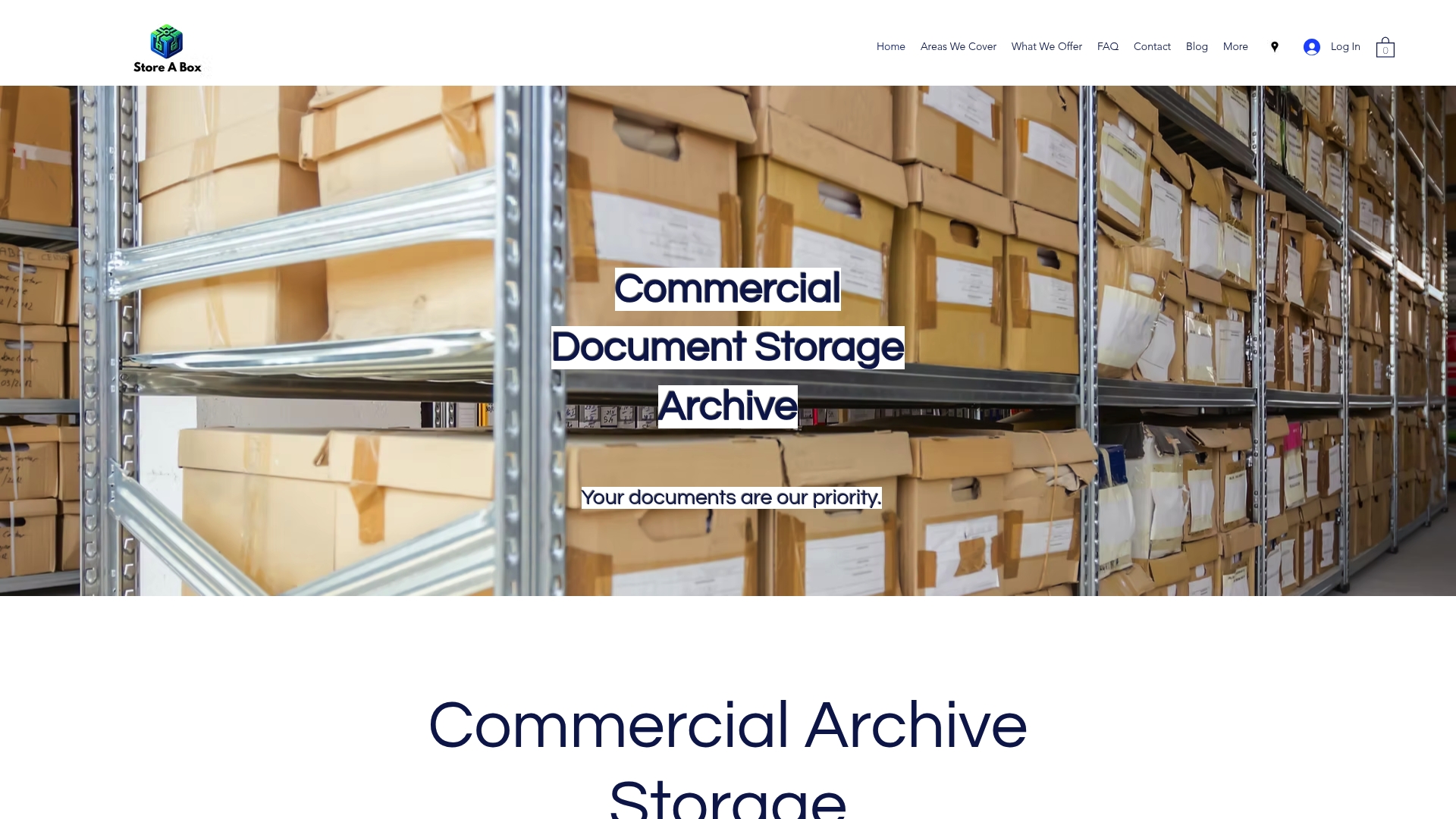Document Storage FAQs for Business and Legal Practices 2025
- Natalie Stephens
- Jun 6, 2025
- 8 min read
Document storage is a ticking clock for businesses and legal practices, especially with UK law requiring financial records to be kept for at least six years. Most assume more storage means more clutter and risk. The real surprise is that hybrid strategies combining digital and physical storage can actually slash long term costs while boosting compliance, security, and efficiency, often making your documents safer than ever.
Table of Contents
Quick Summary
Key Document Storage Questions Answered
Businesses across various sectors face complex challenges when managing critical documents. Understanding document storage requirements is not just about compliance but about protecting your organisation’s most valuable information assets.
Common Legal and Compliance Concerns
Document retention represents a critical operational responsibility for businesses. According to GOV.UK, UK businesses must maintain financial records for a minimum of six years. This requirement extends beyond simple archiving—it demands a strategic approach to document management that balances legal obligations with practical storage solutions.
The landscape of document storage in 2025 has transformed dramatically. Secure Storage Services highlights that businesses now must navigate increasingly complex regulatory environments. Key documents such as financial statements, employee records, contracts, and tax documentation require meticulous preservation strategies.
Digital and Physical Storage Considerations
Modern document storage solutions blend physical and digital approaches. Hybrid storage models have emerged as a pragmatic response to evolving workplace dynamics. Plan2Scan reveals that organisations are increasingly adopting integrated storage systems that provide:
- Secure Access
: Remote document retrieval capabilities
- Compliance Protection
: Built in GDPR safeguards
- Cost Efficiency
: Reduced physical storage requirements
Businesses must consider multiple factors when selecting document storage approaches. Physical storage remains crucial for original documents with legal significance, while digital systems offer enhanced searchability and backup capabilities. The optimal strategy depends on your specific industry, regulatory requirements, and operational complexity.
Strategic Document Management Principles

Effective document storage goes beyond mere preservation. It involves creating systematic processes that protect sensitive information while ensuring quick, authorised access when needed. This means implementing robust categorisation methods, clear retention schedules, and secure disposal protocols.
Key considerations include understanding which documents require long term retention, identifying sensitive information that needs heightened protection, and developing clear protocols for document lifecycle management. Organisations must balance accessibility with security, ensuring that critical information remains both protected and readily available to authorised personnel.
While technological solutions play a significant role, human expertise remains fundamental. Training staff in proper document handling, understanding legal requirements, and maintaining consistent management practices are equally important components of a comprehensive document storage strategy.
The complexity of document storage demands a nuanced, adaptable approach. By combining technological solutions with strategic planning, businesses can transform document management from a potential compliance risk into a streamlined, secure operational strength.
Meeting Compliance and Legal Requirements
Navigating the complex landscape of legal and regulatory requirements for document storage demands precision, strategic planning, and a comprehensive understanding of UK business regulations.
Understanding Regulatory Frameworks
Documentary compliance is not merely a bureaucratic exercise but a critical business protection mechanism. Apex Accountants emphasise that UK businesses must retain financial records for a minimum of six years to satisfy HMRC regulations. This requirement spans multiple document types including financial statements, tax records, invoices, and critical business correspondence.
The legal landscape is increasingly sophisticated. Organisations must develop robust document retention policies that explicitly reference relevant legislation such as GDPR, data protection regulations, and industry specific compliance standards. These policies serve as foundational blueprints for managing sensitive information throughout its lifecycle.
Electronic Record Management Standards
Digital document management introduces unique compliance challenges. Jatheon highlights that electronic records must be stored in secure, non-editable formats with robust retrieval capabilities. Key requirements include:
- Immutable Storage
: Preventing unauthorized modifications
- Quick Access
: Enabling rapid document retrieval
- Comprehensive Search
: Facilitating efficient information location
Businesses must implement technological solutions that not only store documents securely but also maintain their legal integrity. This involves using advanced encryption, access controls, and audit trail mechanisms that track every interaction with sensitive documents.
Developing Comprehensive Retention Strategies

A strategic document retention approach goes beyond simple preservation. Shredall recommends developing detailed retention schedules that categorize documents based on their legal and operational significance. This approach involves:
Categorizing documents by retention periodEstablishing clear protocols for secure disposalImplementing systematic review processes
Organisations must balance the need for information preservation with the risks associated with unnecessary data retention. This means creating nuanced policies that distinguish between documents requiring long term storage and those that can be securely destroyed after specific periods.
Compliance is not a static concept but a dynamic process requiring continuous adaptation. Regular policy reviews, staff training, and technological upgrades are essential to maintaining robust document management systems that meet evolving legal standards.
The consequences of non compliance can be severe. Regulatory penalties, legal challenges, and reputational damage can result from inadequate document management. By investing in comprehensive, forward thinking document storage strategies, businesses can transform compliance from a potential risk into a strategic advantage.
Choosing Secure and Cost-Effective Solutions
Selecting the right document storage solution requires a strategic approach that balances security, accessibility, and financial considerations. Businesses must navigate complex technological and operational requirements to protect their most critical information assets.
Evaluating Storage Infrastructure Options
Modern document storage demands a nuanced approach. Plan2Scan recommends a hybrid model that combines physical and digital storage strategies. This approach provides organisations with maximum flexibility and protection.
Physical storage remains crucial for original documents with legal significance, while digital systems offer enhanced searchability, backup capabilities, and remote access. The optimal solution depends on specific industry requirements, document sensitivity, and organisational workflow patterns.
Key considerations include storage capacity, security protocols, retrieval speed, and scalability. Businesses must assess their unique operational needs against potential storage solutions, ensuring that the chosen system can adapt to evolving technological and regulatory landscapes.
Security Protocols and Access Management
Document storage security extends far beyond physical protection. Cybersecurity Insights emphasises the critical importance of comprehensive access management strategies. Effective security involves:
- Encryption
: Protecting digital documents from unauthorized access
- Access Controls
: Implementing multi-factor authentication
- Audit Trails
: Tracking document interactions and modifications
Organisations must implement robust technological safeguards that prevent data breaches while maintaining operational efficiency. This requires sophisticated systems that balance strict security protocols with user-friendly access mechanisms.
Cost-Effective Storage Strategies

Financial considerations play a significant role in document storage decisions. Smart organisations look beyond immediate storage costs, considering long-term operational efficiency and potential risk mitigation.
Business Storage Solutions recommends several strategies for managing storage expenses:
Implementing digital archiving to reduce physical storage requirements
Developing clear document retention and disposal policies
Investing in scalable storage solutions that grow with organisational needs
The most cost-effective approach involves a comprehensive assessment of current document management practices. This includes analysing existing storage infrastructure, identifying redundant or obsolete documents, and developing a streamlined storage strategy.
Technology continues to revolutionise document storage solutions. Cloud-based systems, advanced encryption technologies, and artificial intelligence-driven document management tools are transforming how businesses approach information storage and retrieval.
Ultimately, choosing a document storage solution is about finding the right balance between security, accessibility, and financial prudence. By carefully evaluating technological options, implementing robust security protocols, and maintaining a strategic approach to document management, businesses can create a storage infrastructure that protects their most valuable information assets while supporting operational efficiency.
Best Practices for Efficient Record Management
Efficient record management represents a critical operational strategy that goes beyond simple document storage. Organisations must develop sophisticated approaches that balance accessibility, security, and regulatory compliance.
Document Classification and Lifecycle Management
Plan2Scan recommends a strategic approach to document management through comprehensive classification systems. Businesses should categorise documents into distinct operational tiers:
- Active Documents
: Frequently accessed records essential for daily operations
- Archived Documents
: Legally required records maintained for long term preservation
- Disposable Documents
: Materials with limited operational or legal significance
This classification approach enables organisations to allocate storage resources more effectively. Active documents require immediate accessibility and robust digital infrastructure, while archived documents can be stored in more specialised, secure environments designed for long term preservation.
Environmental and Physical Storage Considerations
Newbury Self Store emphasises the critical importance of environmental protection for physical document storage. Paper records are particularly vulnerable to degradation from environmental factors such as humidity, temperature fluctuations, and potential physical damage.
Key environmental protection strategies include:

Maintaining climate controlled storage facilities
Using acid free storage containers
Implementing humidity control mechanisms
Creating protective barriers against potential water or temperature damage
Digital backup remains an essential complementary strategy. By maintaining digital copies of critical physical documents, organisations create redundancy that protects against potential physical document loss or degradation.
Technology and Workflow Integration
Cybersecurity Insights highlights the evolving technological landscape of document management. Modern record management goes beyond simple storage, integrating advanced technologies that enhance operational efficiency.
Key technological considerations include:
- Automated Indexing
: Using artificial intelligence to categorise and tag documents
- Secure Cloud Integration
: Creating robust, encrypted digital storage solutions
- Access Logging
: Implementing comprehensive audit trails for document interactions
Workflow integration represents a sophisticated approach to record management. This means developing systems that seamlessly connect document storage with operational processes, enabling quick retrieval, secure sharing, and comprehensive tracking.
Effective record management requires a holistic approach that combines technological innovation, strategic planning, and rigorous compliance protocols. By developing flexible, intelligent document management systems, organisations can transform record storage from a potential administrative burden into a strategic operational asset.
The most successful businesses view document management not as a static process but as a dynamic, continuously evolving strategy that adapts to technological advances, regulatory changes, and organisational growth.
Frequently Asked Questions
What are the document retention requirements for UK businesses?
UK law requires businesses to retain most financial records for a minimum of six years to comply with HMRC regulations. This includes documents such as financial statements, tax records, and invoices.
How can a hybrid document storage model benefit my business?
A hybrid storage model combines digital and physical storage, offering flexibility, enhanced security, and cost-efficiency. This approach allows businesses to protect original legal documents while leveraging the accessibility of digital systems.
What are key security measures for document storage?
Essential security measures for document storage include implementing encryption, access controls (such as multi-factor authentication), and maintaining audit trails to track document interactions, ensuring the protection of sensitive information.
How should documents be classified for effective management?
Documents should be classified into active, archived, and disposable categories. This classification optimises resource allocation, enhancing retrieval efficiency and ensuring compliance with retention policies.
Transform Compliance Stress into Total Confidence with Store a Box
Have you ever felt overwhelmed by the pressure to balance regulatory compliance, document security, and cost-effective storage? This article highlights common frustrations, from the risk of non-compliance to the headaches of keeping up with complex retention schedules and ensuring both digital and physical records are protected. At Store a Box, we specialise in turning these worries into peace of mind. We offer over 30 years of experience helping businesses and legal practices just like yours manage documents in a hybrid system that ticks every compliance and security box. Our friendly team delivers the commercial strength and security solutions you deserve, both locally and nationally.
Why wait and risk a costly mistake? Visit Store a Box now to see how we can help you build a custom document storage plan that is both reliable and future-proof. Contact us today for a free consultation and take the next step towards stress-free document management. Your files, your security, your compliance. All taken care of.



Comments